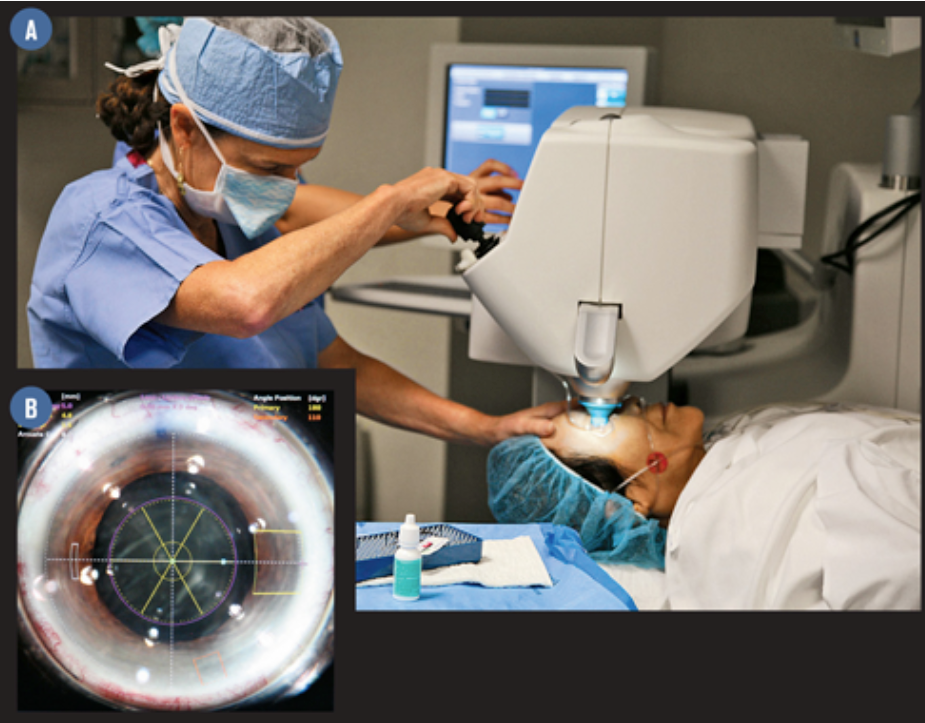Unlock the potential of refractive surgery
Modern refractive surgery offers additional approaches for collaborative patient care.

Given that 88 percent of annual eye exams are conducted by optometrists, it might seem strange that merely 20 percent of LASIK cases are referred to ophthalmologists by ODs. What’s the disconnect? Kyle Sandberg, OD, FAAO; Bobby Saenz, OD, MS, FAAO; and Michael Shumski, MD, sought to answer this question by providing an overview of the spectrum of modern refractive surgery at the American Academy of Optometry 2019 meeting
in Orlando.
Related: Managing dry eye key to patient satisfaction after cataract, refractive surgeries
Refractive treatment options
Among the treatment options for refractive surgery, laser-assisted in situ keratomileusis (LASIK), photorefractive keratectomy (PRK), and the more recent small incision lenticule extraction (SMILE) techniques are the most common.
Modern laser technology for used in these approaches is improving, offering more accurate results and better outcomes for patients. It is easier than ever for surgeons to create corneal flaps at the proper depth, improve refractive outcomes, and reduce side effects during procedures. For example, the blackouts experienced by some patients during flap creation can be addressed with newer laser platforms.
“With VisuMax Femtosecond Laser (Zeiss), it’s down to zero,” Dr. Shumski says.
These advances apply to PRK as well with new protocols to prevent corneal haze and better bandage contact lenses that accelerate epithelial healing.
Related: How to determine an ideal LASIK candidate
Phakic implants
For patients who don’t fit the criteria for more traditional refractive therapies, phakic implants such as Visian Implantable Collamer Lens (ICL, Staar Surgical) and Verisye (AMO) offer a new fresh approach.
New options on the market, such as toric ICLs, were approved to treat myopic reduction up to 20.00 D, and they are changing the way we deliver refractive care. Just like with LASIK, patients receiving phakic implants must undergo a pre-surgical evaluation to determine whether
they will be successful. But ODs using these newer implants will need to make sure they’re evaluating the right criteria.
In particular, temporary intraocular pressure (IOP) spikes are a concern for ICLs. As such, the vault measurement is crucial to monitor.
“Troubleshooting early on with IOP is really important for grading the vault,” Dr. Saenz says.
Related: Measurements matter in cataract surgery, the new refractive procedure
Presbyopia management
For concerns like presbyopia, ODs may need to take a blended approach to refractive care.
“You can do blended vision with any of the laser vision correction procedures or even ICL,” Dr. Saenz says.
Blended options for presbyopia management include the following approaches:
– LASIK, PRK, ICL, SMILE
– Corneal inlays
– Refractive lens exchange
ODs should also consider the presbyopic IOLs on the market, including monovision, accommodating, trifocal, and extended depth of focus lenses.
Related: Surgical, medical approaches making waves in presbyopia
Screening and expectations
Particularly for patients with more complex vision needs like presbyopia, it is crucial for ODs to screen refractive surgery candidates carefully and establish clear expectations for outcomes from the beginning.
A good candidate for refractive surgery is someone who is low risk for complications.
The best way to make assessments and help patients understand what to expect from their treatments is to become familiar with available research and technologies.
Getting familiar with current research and the technologies available are the best way to make these assessments and help patients understand what to expect from their treatments.
“Patient-reported outcomes are critical,” Dr. Saenz says, especially in managing after-effects of refractive cataract surgery.
This is a key aspect of managing outcomes for patients undergoing refractive cataract surgery. ODs should make sure to understand their patients’ activities of daily living and what type of correction they’re used to.
Related: Cataract surgery problem solving: Is technology the answer?
Overall shift to collaborative care
Alongside the new refractive surgery options available to ODs is a change in attitude. Optometrists should avoid falling into a referral mindset in which patient care is managed by individual providers and instead embrace the concept of collaborative care.
Both optometrists and ophthalmologists have their own strengths and roles to play in patient care. “Ophthalmologists want your help,” Dr. Shumski says.
From patient education to inter-office communication to follow-up evaluations, there is a lot that ODs can do to facilitate these collaborative relationships.
“Know who is in your area, know what they offer, and discuss those offers with them,” he says.

Newsletter
Want more insights like this? Subscribe to Optometry Times and get clinical pearls and practice tips delivered straight to your inbox.